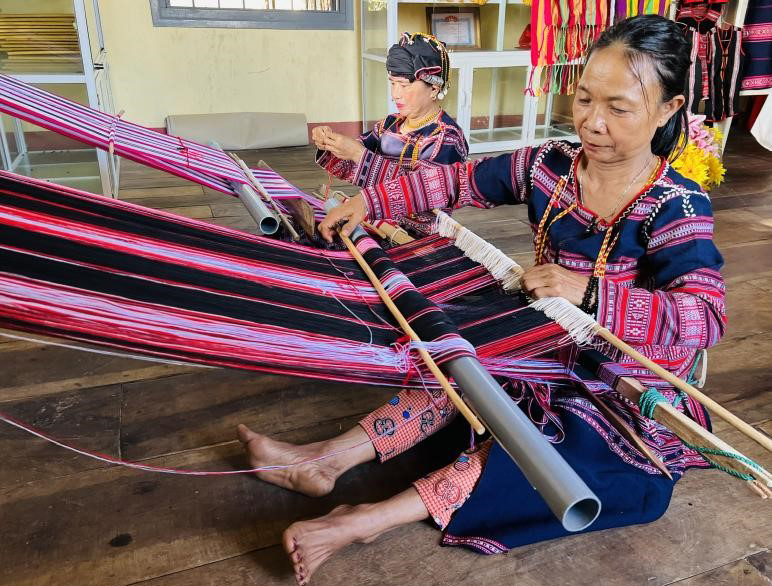Xi Thoai Village (Xuan Lanh Commune, Dong Xuan District, Phu Yen Province), predominantly inhabited by the Ba Na ethnic group, with over 95% of its population, is renowned for its brocade weaving - a traditional art form integral to the cultural identity of the community. Over the centuries, this craft village has experienced rise and fall, at times facing dying trade.

Brocade weaving being a special cultural feature of the Ba Na ethnic community in Xi Thoai village
Brocades are intricately handwoven fabrics made from flax, cotton, and hemp. Produced using traditional looms by skilled Bana artisans in Xi Thoai Village, Xuan Lanh Commune, these handmade fabrics are noted for their safety and environmental sustainability. Each design woven into the fabric captures the distinctive cultural attributes of this local ethnic group.
The distinctive feature of Ba Na brocade weaving in Xi Thoai Village is the intricate floating patterns that appear hand-embroidered on both sides of the fabric. These brocade textiles are characterized by symmetrical, cube-like designs that symbolize concepts such as the universe, heaven and earth, and yin and yang. Each piece of brocade is a miniature work of art, drawing inspiration from the natural beauty of flowers and leaves, which are deeply intertwined with the Ba Na people's life in the mountains and forests. The Ba Na especially respected the color black and considered it a symbol of natural power, symbolizing the strength and majesty of the wild nature. Red signifies strength and love, while white symbolizes aspirations and dreams.
The Ba Na people use brocade fabric to make costumes such as dresses, loincloths, towels, bags, etc. Men wear pull-over shirts with a low neckline and open chest, short sleeves, and traditional loincloths; women wear pull-over shirts with no neckline cut and pair them with skirts. These skirts are crafted from a single piece of black fabric wrapped around the lower body, embellished with fringe and beadwork. The white ribbon motifs are mainly located between the body and the skirt; the two sleeves are decorated with patterns. The waist of the skirt is woven and embroidered with patterns and tassels at both ends, hanging at both ends to the sides. On festive occasions, Ba Na girls enhance their appearance with vibrant dresses and accessories such as shawls, handbags, and brocade bracelets, complementing their graceful movements in traditional, fluid dances.
Brocade weaving has long been esteemed as a traditional art form and a cornerstone of the cultural identity of the Ba Na people of Xi Thoai Village. This skill has been passed down through generations in a tradition of 'from mother to daughter.' Upon reaching adulthood, Ba Na girls are instructed by their mothers in the art of brocade weaving, viewing it as a vital a way to preserve their unique cultural heritage.
Ms So Thi Nghiep (83 years old), from Xi Thoai Village, said: "In my time, Ba Na boys were expected to be strong and proficient in hunting and farming, while Ba Na girls needed to excel in weaving and brocade crafting to attract a spouse. From the ages of 12 to 15, Ba Na girls are taught by their mothers to weave fabrics for making dresses and festival towels. Mastery of brocade weaving becomes an essential skill as they reach adulthood. However, depending on the ingenuity and creativity, Ba Na's daughter will create different patterns on the fabric, and the costumes are the "measure" of the bravery and ingenuity of Ba Na girls.
Along with the rapid growth of the commodity economy, traditional handicraft products, particularly brocade textiles, have faced declining competitiveness, leading to difficulties in market access and a diminishing interest in loom weaving. As a result, many people have shifted from traditional ethnic attire to ready-made garments commonly worn by the Kinh people. Traditional costumes are now reserved primarily for festive occasions, while only a few elderly women, deeply passionate about brocade weaving, continue to preserve and safeguard this craft. Consequently, the traditional art of brocade weaving among the Ba Na people of Xi Thoai has long been at risk of disappearing.
According to the brocade weavers of Xi Thoai Village, one major factor contributing to the decline of traditional weaving is the difficulty in competing with mass-produced textile products. Ms. Nguyễn Thị Ry explained that the brocade weaving process involves highly intricate and sophisticated craftsmanship, with the creation of a traditional dress requiring several months of work. Consequently, the cost of these products ranges from 1 to 3 million VND each. In contrast, machine-woven brocade products available on the market are diverse in design, pattern, and size, and are offered at significantly lower prices. This disparity makes it challenging for traditional weavers to sustain their craft and find a market for their products.
Comrade Ho Thanh Hai, Vice Chairman of the Xuan Lanh Commune People's Committee, stated: "In response to the threat of losing Xi Thoai's brocade weaving tradition, the Party Committee and People's Committee of the Commune established a dedicated group in 2000 comprising 16 skilled and passionate women specializing in fabric weaving and embroidery. Despite these efforts, the group has struggled to operate effectively due to challenges in securing markets for their products".
According to comrade Ho Thanh Hai, the survival of the traditional brocade weaving village hinges on establishing a stable source of income for its practitioners. This remains a significant challenge for both the community and local authorities.
Translated by Hai Loan